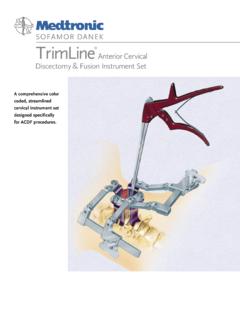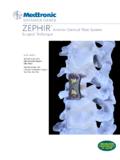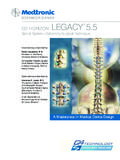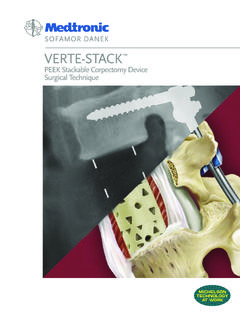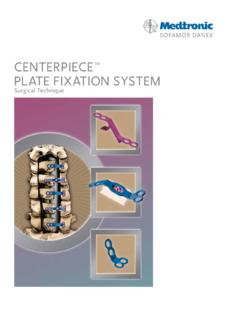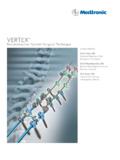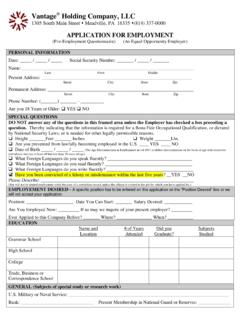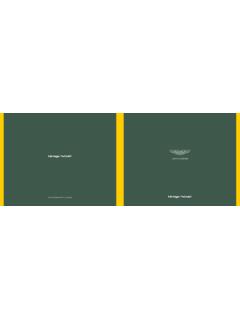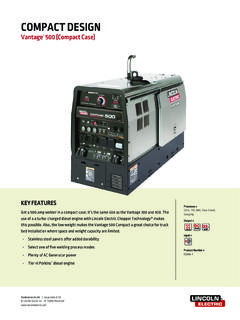Transcription of VANTAGE - MT Ortho
1 As described by:Curtis A. Dickman, Neurological Associates Phoenix, AZRick C. Sasso, Spine GroupIndianapolis, INThomas A. Zdeblick, of WisconsinMadison, WI VANTAGE Anterior Fixation System Surgical TechniquePreface 2 Implants 3 Instruments 4 Surgical Approach/Exposure 6 Surgical Technique Procedure 9 Closure/Postoperative Care/Explantation 18 Product Ordering Information 19 Important Information 20 Surgical Technique Table of ContentsCONTENTS1 Dear Colleague: Anterior internal fixation of the thoracic and thoracolumbar spine is a growing trend in spinal surgery.
2 In the thoracic and thoracolumbar spine, anterior fixation is indicated for burst fractures with significant canal compromise, vertebral body tumors, vertebral osteomyelitis, vertebral osteonecrosis or any other lesions that require corpectomy, and other indications requiring anterior stabilization. Primary advantages of anterior internal fixation include the ability to provide complete canal clearance and decompression of bony fragments and/or total resection of a tumor. Additionally, anterior thoracic and thoracolumbar surgery allows for fusion of a minimum number of motion segments, thus allowing for more normal spinal mechanics. The specific goal in the development of the VANTAGE Anterior Thoracic and Lumbar Fixation System was to design a plating system that stabilizes thoracic, thoracolumbar, and lumbar burst fractures, tumors, and other unstable pathology while facilitating neural decompression and the restoration of vertebral height and lordosis.
3 The VANTAGE Anterior Plating System allows for precise distraction outside the interbody space to aid visualization and decompression of the spinal canal. The plate permits anterior load sharing and is MRI compatible. The VANTAGE Anterior Fixation System consists of unique vertebral body staples, screws, and plates that are anatomically accommodating and low in profile. Through extensive testing, design modifications, and continuous review, the design goals have been met and exceeded. The VANTAGE Anterior Fixation System incorporates a truly revolutionary design that allows for maximum surgical simplicity and intra-operative flexibility. Sincerely,Curtis A. Dickman, Rick C. Sasso, Thomas A. Zdeblick, Technique PrefacePREFACE2 THORACIC PLATE Sizes Range to 8cm in IncrementsSurgical Technique Implant Features and BenefitsIMPLANTS3 Sized to Fit Lumbar SpineSlot Allows 3mm CompressionSizes Range 4cm to 10cm in IncrementsATL ROSTRAL STAPLEATL CAUDAL STAPLEATL PLATELOCK NUTATL SCREWD iameter x 30mm to 55mm LengthContoured to Fit Lumbar SpinePlates: Smooth Surfaces Holes for Visualization of Graft Radial Splines Ensure Rigid Fixation to StapleScrews: Self-tapping Cutting Flute for Easy Insertion Color-coded for Anatomical Placement Internal Hex for Flush FittingStaples.
4 Color-coded for Anatomical Placement Low Profi le Easy-to-start Thread Design Medial Prongs for Preservation of Endplates Top-loading, Top-tightening Splines Ensure Rigid Fixation to Plate Interchangeable with Plates (Thoracic or Lumbar) Allows for 10 of Screw Angulation THORACIC SCREW Diameter x 15mm to 50mm LengthTHORACIC STAPLEBACK VIEW OF ATL Tap 8684500 Counter Torque Wrench 9339040 Torque Limiting Nut Driver 9339042 Hex Driver 9339031 Awl 9339096 Quick Connect Ratcheting Handle 9339082 Screw Gauge 9339075 ParallelCompressor 9339094 Surgical Technique InstrumentsPlate Pusher/Counter Torque 9339005 Fixed Quick Connect Egg Handle Tap 836-015 Quick Load Distractor 9339085 Modular Drill Bit Handle 9339010 Fixed Drill Bit 9339021 Depth Gauge 870-501 ATL Freehand Drill Guide 9339003 Thoracic Staple Impactor/Awl Guide 9339001 Surgical Technique InstrumentsINSTRUMENTS5 Thoracic Freehand Drill Guide9339004 Freehand Staple Impactor Shaft9339002 Caliper 9339095 Modular Distractor Rack
5 9339060 Modular Distractor Barrels 9339061 When treating thoracic and thoracolumbar fractures or tumors with anterior instrumentation, it is important to ensure the patient is positioned in a true lateral position and that the position is maintained throughout the procedure (Figure 1). The approach can be made from the patient s left or right side. Occasionally, lateral deviation of the aorta will necessitate a right-sided approach. The preoperative axial MRI or CT should be evaluated to determine the position of the aorta relative to the spine (Figure 2). If neutral pathology essentially displaces the spinal cord toward one side, then the procedure should approach the side where the compression is greatest to avoid excessively manipulating the spinal Technique Surgical Approach/ExposureAPPROACH6 Figure 1 Figure 2 Surgical Technique ExposureEXPOSURE7 Figure 4 Figure 3 The incision depends on the level of the pathology.
6 For thoracic segments, the rib is resected two levels above the lesion. At the thoracolumbar junction, the approach is through the bed of the tenth or eleventh rib. Checking an A/P radiograph may help determine which rib to use. Thoracolumbar lesions may require peripheral division of the diaphragm. Mid to low lumbar lesions are approached retroperitoneally. Thoracolumbar Junction Exposure:Following a skin incision paralleling the tenth rib and transection of the latissimus dorsi muscle in line with the skin incision, the tenth rib is subperiosteally exposed, stripped, and removed. It is divided anteriorly near the costal cartilage and posteriorly back to its angle. The chest is then entered sharply and the pleura is incised (Figure 3).Following the pleural opening, the lung is visualized and retracted.
7 The diaphragm separates the pleural cavity from the peritoneal cavity. The entrance to the retroperitoneum is at the costal cartilage of the tenth rib shown in the lowerleft-hand corner of Figure Rib BedDiaphragmLungDiaphragm10th Rib Costal CartilageAnteriorPosteriorAnteriorPoster iorPleuraFigure 6 Figure 5 The peritoneum is swept off the undersurface of the diaphragm, which is mobilized to expose the spine. The diaphragm is radically incised, leaving a peripheral cuff attached to the chest wall. The edges of the diaphragm are tagged along the way for later closure (Figure 5). The diaphragm is incised down to the disc, which is then seen between the distal edge of the pleura and the proximal portion of the psoas contents are swept anteriorly off the proximal edge of the psoas muscle to expose the surface of the thoracic and lumbar spine (Figure 6).
8 Surgical Technique Exposure (Continued)EXPOSURE8 RetroperitonealFatDiaphragmRetroperitone alFatDiaphragmAnteriorPosteriorAnteriorP osteriorFollowing adequate confirmation of spinal levels, the segmental vessels are isolated, ligated, and divided at each vertebral body level to be included in the instrumentation and fusion. The intervertebral discs are then removed after incising the corpectomy is performed at the level(s) at which the spinal cord needs to be decompressed or at levels that pathology is present. This is accomplished by following the steps listed below, which are illustrated in Figure 7. Corpectomy:1) The rib head and pedicle are removed to expose the spinal ) Discs are incised at margins of body to be resected. The anterior and contralateral walls of the vertebral body are usually preserved in a routine ) Vertebral bodies are removed with rongeurs, drills, and ) The spinal cord is decompressed with microsurgical curettes to remove epidural compression.
9 Using a Depth/Screw Sizing Gauge, measure the coronal diameter of the vertebral body above and below the corpectomy. This distance is used to determine the length of the screws to be used. This measurement may also be performed by using the graduated scale on the preoperative MRI/CT films (Figure 8).Surgical Technique CorpectomyCORPECTOMY9 Figure 7 Apply Width to Scale Provided on MRIThe screw length can also be de ter mined by mea sur ing the ver te bral body width on a preoperative CT scan or MRI scan. Use the scale pro vid ed on the scan to ac com mo date mag ni fi ca tion. Measure WidthFigure 8 Figure 11 The appropriate-sized staple is selected, and the Staple Impactor Shaft is used to position it in place (Figure 9). Staples are available in thoracic and lumbar sizes.
10 The colors of the staples dictate the orientation of the staples (dark green caudal, light green rostral, dark blue caudal, and light blue rostral). The staples are mirror images of each other and interchangeable. Use the largest staple that will fit within the confines of the vertebral body. The posterior margin of the staple should be as near to the posterior edge of the vertebral body as possible (Figure 10). Impact the staple in place using a mallet (Figure 11).Surgical Technique Staple PlacementPLACEMENT10 Figure 10 Figure 9 The Drill Guide is now slipped over the Staple Impactor Shaft and held firmly against the staple (Figure 12). The staple should be flush against the vertebral body. If the staple is not flush, removal of protruding bone with a burr may be the Drill Guide over the staple, the drill or awl will create a trajectory for the posterior screw that is 10 anteriorly.


